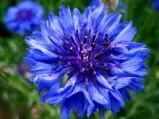Centaurea cyanus
Lisa gave me an article from Prevention Magazine listing some flowers and their herbal uses in cosmetics. It was surprising to find the common blue cornflower or bachelor button among the roses and echinacea. Rarely is this flower listed as an herbal remedy.
Cornflower has historically been used as an anti-inflammatory and astringent, especially in treating eye ailments. Modern research suggests that this is due to polysaccharides, mainly composed of galacturonic acid, arabinose, glucose, rhamnose and galactose. This action has been utilized in modern cosmetics for the reduction of puffiness. A couple of these are Klorane Smoothing and Relaxing Patches with cornflower ($18) or Talika Eye Dream Regenerator Mask ($55).
If you grow cornflowers and want to avoid buying expensive cosmetics you can use them to make a poultice. Grind dried flowers in a mortar or in a blender until they are powder. Add just enough water to make a thick paste. Place this in a piece of cloth and apply it to the area around the eyes.
With fresh flowers add 2 ounces of the fresh herb to about a half a cup of water in a sauce pan. Simmer for two minutes. Cool and place the untrained concoction in a cloth and apply.
A third way is to steep 1 tsp. dried or 2 tsp. fresh cornflowers in 1 cup hot water for 10 minutes. After straining chill the liquid in the refrigerator until quite cold. Soak cotton balls, makeup pads or an eye mask in the liquid. Wring lightly and place over the closed eyes encompassing the puffy areas. Allow to remain for 10 to 15 minutes. If you have an allergy to daisies (or any flower) use caution.
